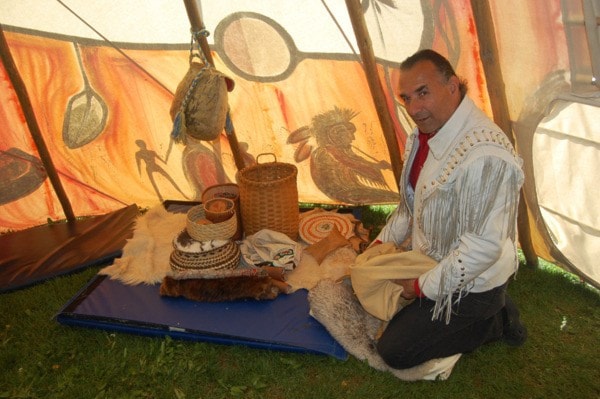FIRST NATIONS’ culture is thousands of years old but that doesn’t make it irrelevant to today.
That’s part of the message Tony Sullivan talks about in his Teepees in Schools presentations to schoolchildren about first nation culture east of the Rocky Mountains.
He was here last week to talk to students at Suwilaawks and Cassie Hall schools.
Students are told to ask questions about what they’re interested in and that includes when they’re in the teepee that Sullivan set up on the lawn at both schools here.
“Often times the questions lead into discussions such as the environment, environmental protection and use of natural material and guardianship of the environment, our connection and responsibility to the environment,” says Sullivan, “so everything, although it might sound like ancient cultural stuff, it’s actually relevant today in many ways.”
Sullivan is Anishnabe from Ontario.
The Anishnabe culture’s traditional lands stretch from Peace River country to south Florida and from the Columbia Valley east to Labrador, – one of the largest first nation groups in North America, he says.
“The reason we had a vast area is because we had the birch bark canoe, which gave us mobility all over the continent,” he says.
People from the east would travel from Thunder Bay, Ontario with copper to trade in Kitamaat for oolichan grease, he says.
One difference between cultures on either side of the mountains was that west coast people didn’t use the portable teepee, except occasionally as temporary lodges for hunting, but for the most part, they had permanent houses as they didn’t have as much reason to travel as much as people from the east, says Sullivan.
His culture had wigwams as its permanent structure, he says.
While teepees are cone-shape, wigwams are shaped like an upside down dome, or like a stretched igloo, he explains.
He began doing presentations in schools after he started manufacturing teepees 15 years ago and found out how much stereotyping and misinformation was out there based on movies and media that was giving information from the wrong sources.
First, he did a volunteer program for his son’s school Grade 4 class.
He had a teepee on the roof of his car and it was National Aboriginal Day so he asked the principal if he could do a volunteer program with students in the teepees for 15 minutes.
A few days later, another principal called to ask if he would do the same and it grew from there.
“I realized there was a really big need for this because of the lack of accurate information in our society,” he said. “It’s a day kids will never forget at school. I like to do that: give kids memories they’ll never forget.”
Things have improved in the last 15 to 20 years, he says.
“The current day-to-day news is much better than it used to be. People are taking the initiative to inform themselves,” he says.
But the movie industry continues to promote stereotypes because it sells, he says.
He acknowledged our local first nations for having him here and being gracious in allowing him to do education programs in their area.
